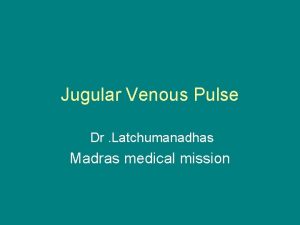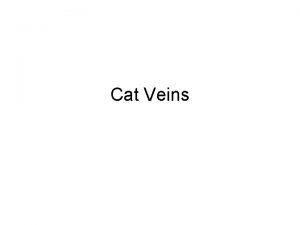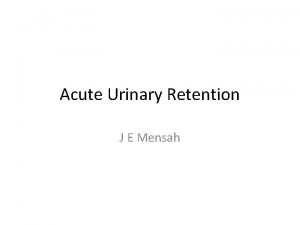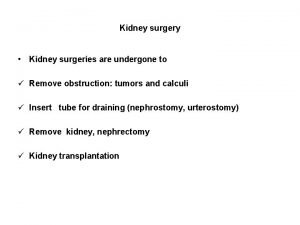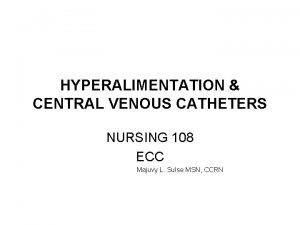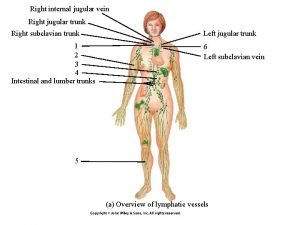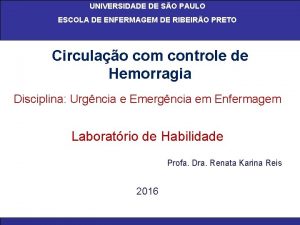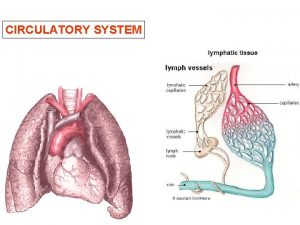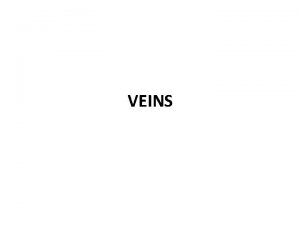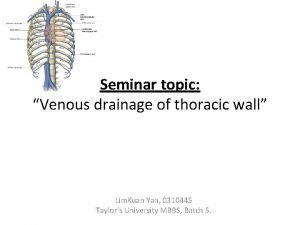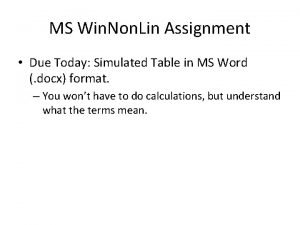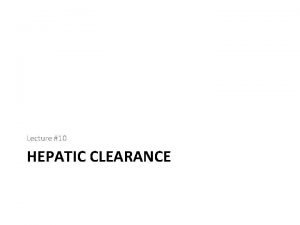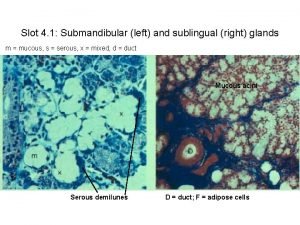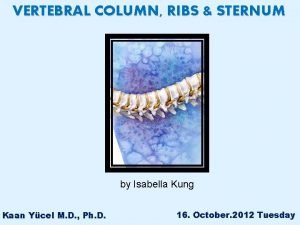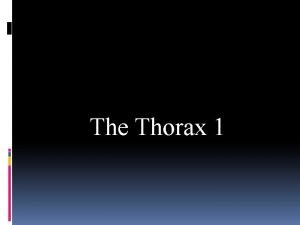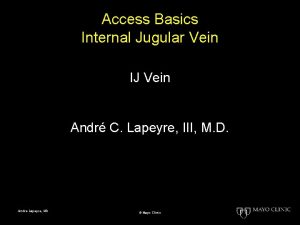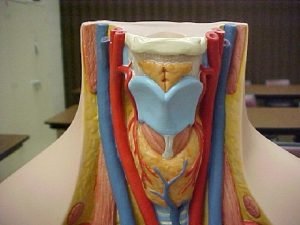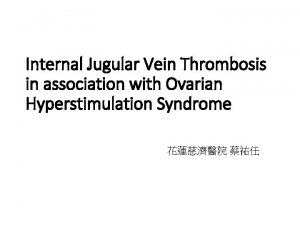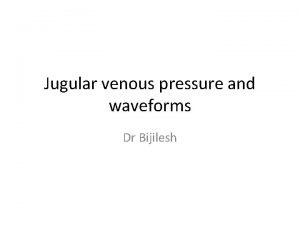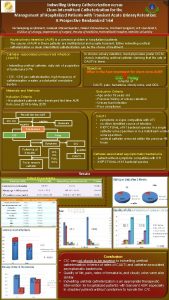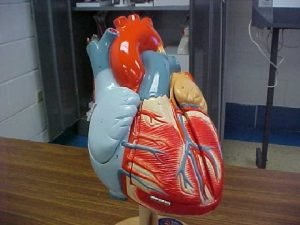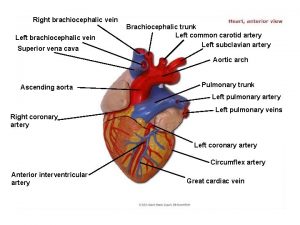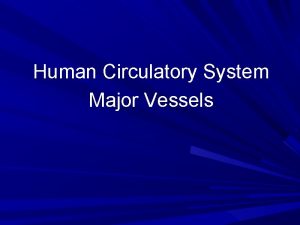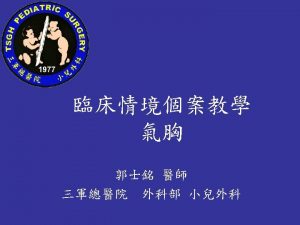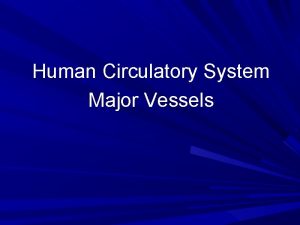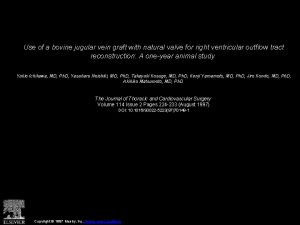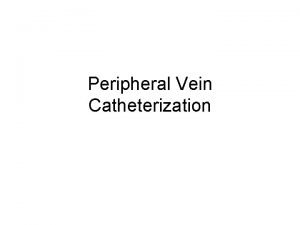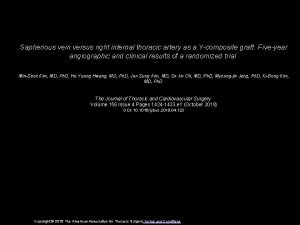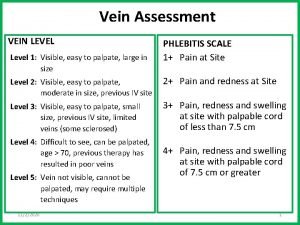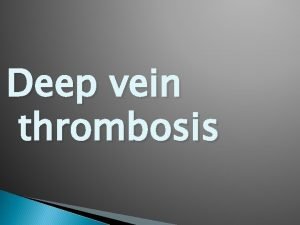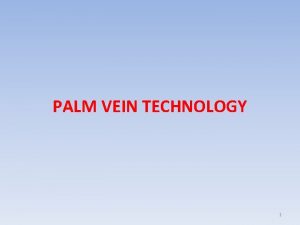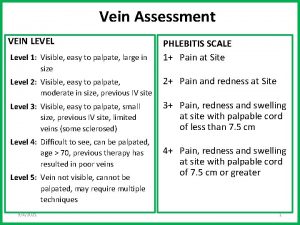Right Internal Jugular Central Vein Catheterization M Zwank


























- Slides: 26

Right Internal Jugular Central Vein Catheterization M. Zwank Updated 10/4/2014

INDICATIONS CONTRAINDICATIONS • Definitive access in difficult access patients • Critically ill patients needing multiple infusions • Central vein infusions • • • – ie. pressors Uncooperative patient Known IJ DVT Adequate peripheral access Bleeding diathesis Consider femoral if hyperkalemia or hypothermia or otherwise irritable heart

Equipment • • Face Shield Hair Covering (bouffant cap anyone? ) Sterile Gown Sterile Gloves for attending when you miss it Central Line Kit Ultrasound Machine, Probe Covering Saline Flush(es)

Equipment • At Regions Hospital, everything you need is in the: – Critical Procedure Cart – Bright Red – located on Pod E & A – Stocked by Materials Management

Anatomy • Multiple traditional approaches – Anterior, central (most common), posterior • IJ generally courses lateral to carotid but don’t count on it lateral medial • Use ultrasound SCM • Seriously, use ultrasound IJ C

Why Bother With Ultrasound • It is standard of care! • Multiple multiple studies support it • Most importantly, takes all trepidation out of procedure – Priceless

Challenges – Internal Jugular • Anatomic Variations (Troianos) – 1009 patients admitted for surgery – 54% had internal jugular vein overlying carotid to some degree • Double wall puncture (Docktor) – 150 patients – Double wall puncture in 30 Troianos CA, et al. Anesthesiology 1996; 85: 43– 8; Docktor B, et al. Can Assoc Radiol J 1996; 47: 195– 201.

Real Life Examples

Universal Protocol ! ! ! • Guidelines intended to prevent procedure errors – Wrong Site – Wrong Procedure – Wrong Person • Required by JCAHO • Currently applicable to several ED procedures – Central Line, LP, Thora/Paracentesis, Chest Tube • Includes three major steps

Universal Protocol Three Steps • The verification processes to confirm – Correct Patient – Correct Procedure – Correct Site • The marking of the procedure site • A “time-out” immediately before starting the procedure

Procedure • • Consent if possible Prep Perform Confirm

Prep • Gather everything, Relax, Clear your head • TIME OUT • Ultrasound machine on – Get a preliminary look at the vein and its course • • • Patient in Trendelenburg Wash hands Head covering, face covering, gown, gloves Open kit Sterile Prep and Drape

Perform • • • Prepare items to be used Flush and clamp ports Locate vein with ultrasound Anesthetize skin and tissue Needle to vein, be careful of tenting vein Get flash of blood, hold needle still

Perform • Wire – Rotate wire and/or needle 90° if trouble wiring • • Skin nick (be generous) Dilate tissue to vein Catheter over wire Draw and flush ports Secure with suture Secure line Apply sterile dressing

Confirm • Generally CXR shows correct vessel and depth • Consider ultrasound in acute scenarios – Rapid saline flush into line will be seen in R atrium / ventricle on ultrasound

Cautions • • Stop if you break sterile technique Don’t sweep needle when in tissue Never let go of guidewire Don’t force guidewire Watch for cardiac ectopy if wire is too deep Stop procedure if arterial stick Pay attention to depth Clean up your sharps after!

Notes About Ultrasound • Out of Plane / Transverse – Most Common – Challenge is to follow TIP of needle – Slide probe as needle advances – Often watching tissue movement to help • In Plane / Long Axis / Longitudinal – Less Common – Challenge is to remain exactly in plane of needle – Keep probe steady – Can use needle enhancement on Sonosite

US probe Find vessel, pick landmark Skin IJ 18

US probe Advance Needle Skin IJ 19

US probe Slide probe toward you – find the needle on the screen Skin IJ 20

US probe Slide probe away from you – make needle disappear from screen Skin IJ 21

US probe Slide probe away from you – make needle disappear from screen Skin IJ 22

US probe Advance needle – make needle reappear on screen Skin IJ 23

US probe Advance probe – make needle disappear from screen again Skin IJ 24

US probe Advance needle – make needle reappear on screen again Skin IJ 25

Video http: //www. nejm. org/doi/full/10. 1056/NEJMvcm 055053 Start video at Chapter 4; 6: 10
 Ventricularization
Ventricularization Internal jugular central line
Internal jugular central line Right product right place right time right price
Right product right place right time right price Right time right place right quantity right quality
Right time right place right quantity right quality Anterior jugular vein
Anterior jugular vein Occipital artery
Occipital artery Neck tendon
Neck tendon Popliteal lymph nodes
Popliteal lymph nodes Subscapular vein cat
Subscapular vein cat Bladder catheterization
Bladder catheterization Self catheterization adaptive equipment
Self catheterization adaptive equipment Purpose of catheterization
Purpose of catheterization Bowel wash nursing responsibility
Bowel wash nursing responsibility Intestine
Intestine Jugular interna acesso central
Jugular interna acesso central The right man on the right place at the right time
The right man on the right place at the right time Triangle.of.calot
Triangle.of.calot Right axillary vein
Right axillary vein V. brachiocephalica sin
V. brachiocephalica sin Veins in the chest
Veins in the chest Venule
Venule Sinusoids
Sinusoids Blood flow of liver
Blood flow of liver Liver central vein
Liver central vein Intercalated duct
Intercalated duct Atypical ribs
Atypical ribs Axial vs appendicular
Axial vs appendicular
